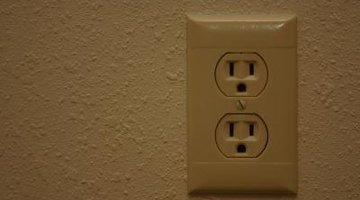GFI Vs. GFCI
In residential electrical settings, modern homes are being fitted more frequently with safety electrical receptacles. These wall or counter plugs, noticeable with labels on them such as GFI or GFCI, are designed to prevent electrocution injury before it gets fatal. As a result, these plugs are frequently installed in areas with a high potential of water splash such as kitchens, bathrooms, outdoor wall plugs and garages.
Definitions

GFCI stands for Ground Fault Circuit Interrupter. GFI stands for Ground Fault Interrupter. Both are intended to work similar to a circuit breaker by cutting power going through them if they sense a sudden load demand and grounding out. In terms of comparison, GFCI and GFI plugs work the same way and offer the same features. The naming of the equipment is the only difference. These plug types are frequently noticeable by the tell-tale button in the middle with the label "reset" or test." This button depresses inward to reset the circuit when it breaks as designed.
Commonalities
GFCI and GFI plugs can be mounted on walls or within panels. Many local and state building codes require these codes in specific structure zones, frequently in high-moisture areas such as laundry rooms. This requirement has been in place and expanding since 1973. They both provide safety for the electrical user and save on damage costs that would otherwise occur when a grounding-out occurs. Such costs can include frying a breaker at the master panel, which can costs hundreds of dollars. In comparison, a GFCI or GFI plug may cost approximately $5 to $20 at a hardware store.
Maintenance
Check and test GFI and GFCI plugs monthly to ensure their safety features. Over time, such plugs can get damaged or worn out, particularly if a grounding-out has already occurred. If the circuit-breaking feature fails, an electrocution injury could be much worse because the current won't be cut off when necessary. You can test by plugging in a light and then pressing the test button on the plug. If the light turns off as the button is pressed, the plug's safety feature works.
How They Work
The GFI or GFCI receptacle plug utilizes a relay inside its inner assembly that senses the electrical load passing through. When the current suddenly decreases, the relay cuts off the current within a second. The plug will not work again until whatever was plugged into it is removed and the relay is reset via the plug button.
References
Writer Bio
Since 2009 Tom Lutzenberger has written for various websites, covering topics ranging from finance to automotive history. Lutzenberger works in public finance and policy and consults on a variety of analytical services. His education includes a Bachelor of Arts in English and political science from Saint Mary's College and a Master of Business Administration in finance and marketing from California State University, Sacramento.
Photo Credits
- Jupiterimages/Photos.com/Getty Images
More Articles



